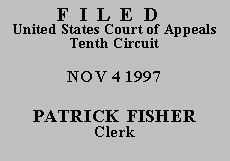

| UNITED STATES OF AMERICA,
v.
DICKIE KIRKHART,
Defendant - Appellant |
No. 96-3335 (District of Kansas) |
Dickie Kirkhart appeals the enhancement of his sentence following his plea of guilty to the charge of armed bank robbery. 18 U.S.C. § 2113(a) and (d). The issues of this case revolve around U.S.S.G. § 3C1.2 which provides:
If the defendant recklessly created a substantial risk of death or serious bodily injury to another person in the course of fleeing from a law enforcement officer, increase by 2 levels.
Defendant contends the district court erred by applying § 3C1.2: 1) without first finding he was actually aware he was being pursued by law enforcement officers, and 2) in the absence of evidence his conduct constituted an actual risk of harm to another. We affirm.
The relative evidence is rather skimpy, but from the record we can discern defendant had been a suspect for some time prior to his ultimate capture. On the day his arrest occurred, officers went to his residence and knocked on the door. Receiving no response after ten minutes, the officers retired to observe the house. Sometime later, a man ultimately proven to be defendant, left the house, got into a vehicle and drove away at a "fast speed." One officer pursued, and when "the speeds reached about fifty miles an hour in the residential neighborhood, [] turned on [his] emergency red lights." Defendant continued to run from the officer, and in the process went through a red light. The officer was able to finally stop the defendant after pulling alongside his car. About this incident, the presentence investigation report states:
On February 15, 1996, Dickie Kirkhart led FBI task force agents on a high speed chase through a residential neighborhood after being made aware that he was being sought for questioning in the September 9, 1995, Intrust Bank robbery. He attempted to elude officers after becoming aware of their surveillance. During the presentence interview, he indicated that at some point during the chase, he was traveling in excess of 50 miles per hour.
Under these circumstances, we believe there was sufficient evidence before the district court from which it could have properly drawn inferences that result in a factual predicate for the imposition of the enhancement. First, we do not suggest the language of § 3C1.2 requires the court to determine the defendant was aware he was fleeing from a law enforcement officer, but assuming that point for the sake of disposition in this case, there was enough evidence that would support the finding.
The presentence investigation report establishes the fact in so many words. Although defendant objected to the paragraph in which the language is contained, that objection was overruled. Second, the pursuing officer used his emergency red lights during the pursuit. Although defendant argues the officer did not do so at the initiation of the chase, we do not believe the distinction is relevant. What is important here is that the display of the emergency lights produced no result and the defendant continued to run. Moreover, the defendant was aware he was being sought for questioning.(1) In light of that knowledge, his refusal to respond to the officers' knock and his conduct thereafter are strong circumstances from which an inference can be drawn that he was attempting to flee from law enforcement officers.
Defendant next contends there is no evidence his high speed traverse of a residential neighborhood and disobedience of a stop light recklessly created a substantial risk of death or serious bodily injury to another person. He posits that unless it can be shown a specific person was put in danger by his actions, the enhancement cannot be employed. We have previously held a similar argument "frivolous." United States v. Fowler, 1993 WL 118843 (10th Cir. Unpublished). Defendant distinguishes Fowler contending he is not asserting the identity of a victim must be established, but the government must show someone was imperiled.
The language of the guideline is not so precise. What triggers its application is the risk of death or injury. We believe a person who speeds through a residential district at fifty miles per hour for some time and fails to stop at a red light risks the death or injury of another. Moreover, the essence of the conduct that justifies the enhancement is its recklessness. See § 3C1.2 Appl. Note 2. The conduct displayed here by the defendant falls within that "gross deviation from the standard of care that a reasonable person would exercise" that would qualify as "reckless." U.S.S.G. § 2A1.4 Appl. Note 1 (made applicable here by § 3C1.2 Appl. Note 2.)
AFFIRMED.
ENTERED FOR THE COURT
John C. Porfilio
Circuit Judge
*. This order and judgment is not binding precedent, except under the doctrines of law of the case, res judicata, and collateral estoppel. This court generally disfavors the citation of orders and judgments; nevertheless, an order and judgment may be cited under the terms and conditions of 10th Cir. R. 36.3.
1.Although the basis for doing so is not clear in the record, the district court found the officers had left a message on Mr. Kirkhart's answering machine. Taking issue with that finding, defendant nonetheless concedes officers left some kind of a message on a recording machine in the home.